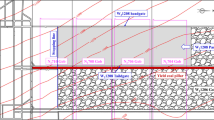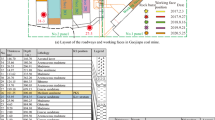Abstract
In the coal measure strata, igneous rocks are often invaded, and their occurrence, size, and distribution form play an important role in mining safety. The breakage of hard and thick igneous rocks easily induces dynamic disasters, such as rock burst, mine seismicity, gas outburst, and surface subsidence, which seriously threaten mine safety production. In view of the working face with overlying hard and thick igneous rocks, the evolution characteristics of mining stress and energy distribution under hard and thick igneous rocks were investigated. Furthermore, the influence law of different horizons and thicknesses of igneous rock on overlying strata movement law, stress distribution, and energy distribution was analyzed based on FLAC3D numerical simulation. Results show that no evident subsidence of the overlying strata exists before the igneous rock is broken. Additionally, the subsidence amount of the overburden is suddenly increased after the igneous rock is broken, thereby showing significant mutability. Before the igneous rock breaks, a high stress area is formed around the goaf, and the stress concentration gradually increases with the increase of the mining scope. After the igneous rock breaks, the coal under high stress is prone to induce dynamic disasters under the action of strong dynamic load. However, the advanced abutment pressure and stored energy rapidly decreased. The accuracy of the numerical simulation is verified by field monitoring. Results of the study are of considerable significance for safe mining of working face under similar geological conditions.



















Similar content being viewed by others
References
Bai QS, Tu SH, Wang FT et al (2017) Field and numerical investigations of gateroad system failure induced by hard roofs in a longwall top coal caving face. Int J Coal Geol 173:176–199
Cao AY, Zhu LL, Li FC et al (2014) Characteristics of T-type overburden structure and tremor activity in isolated face mining under thick-hard strata. J China Coal Sci 39(2):328–335 (in Chinese)
Chlebowski D, Zorychta A, Burtan Z et al (2017) Location of opening-out cross-cuts in relation to rockburst hazard conditions along the face in the light of model testing. Arch Min Sci 62(1):121–130
Gu ST, Huang RF, Tan YL et al (2015) Formation mechanism of anticline structure and its disastrous mechanism of rock burst. J Min Saf Eng 32(1):59–64 (in Chinese)
Guo WJ, Li YY, Yin DW et al (2016) Mechanisms of rock burst in hard and thick upper strata and rock-burst controlling technology. Arab J Geosci 9(10):561
Hao FK, Li HT, Zhou K et al (2014) Study on numerical simulation of main control factors for energy distribution of mine pressure bump. Coal Sci Technol 42(4):31–34 (in Chinese)
He MC, Miao JL, Feng JL et al (2010) Rock burst process of limestone and its acoustic emission characteristics under true-triaxial unloading conditions. Int J Rock Mech Min Sci 47(2):286–298
Jiang PF, Lin J, Zhang J et al (2011) Energy distribution on of coal pillars with different-width in mining close coal seam. Coal Min Technol 16(1):52–54 (in Chinese)
Jiang LS, Zhang PP, Chen LJ et al (2017) Numerical approach for goaf-side entry layout and yield pillar design in fractured ground conditions. Rock Mech Rock Eng 4:1–23
Liu JH, Jiang FX, Feng T (2010) Numerical simulation of abutment pressure distribution of C-shaped stope. Rock Soil Mech 31(12):4011–4015
Lu CP, Liu Y, Wang HY et al (2016) Microseismic signals of double-layer hard and thick igneous strata separation and fracturing. Int J Coal Geol 160–161:28–41
Si RJ, Wang CQ, Tan YL (2007) Numerical simulation of abutment pressure distribution laws of working faces. Rock Soil Mech 28(2):351–354
Song DZ, Wang EY, Li N et al (2012) Rock burst prevention based on dissipative structure theory. Int J Min Sci Technol 22(2):159–163
Song DZ, Wang EY, Liu ZT et al (2014) Numerical simulation of rock-burst relief and prevention by water-jet cutting. Int J Rock Mech Min Sci 70:318–331
Tang JH, Bai HB, Du F (2011) Character of the zonal variation of abutment pressure in working faces. J Min Saf Eng 28(2):293–297 (in Chinese)
Wang L, Cheng YP, Xu C et al (2013) The controlling effect of thick-hard igneous rock on pressure relief gas drainage and dynamic disasters in outburst coal seams. Nat Haz 66(2):1221–1241
Wang W, Cheng YP, Wang HF et al (2015a) Coupled disaster-causing mechanisms of strata pressure behavior and abnormal gas emissions in underground coal extraction. Environ Earth Sci 74(9):1–9
Wang W, Cheng YP, Wang HF et al (2015b) Fracture failure analysis of hard-thick sandstone roof and its controlling effect on gas emission in underground ultra-thick coal extraction. Eng Fail Anal 54:150–162
Wang P, Jiang JQ, Zhang PP et al (2016a) Breaking process and mining stress volution characteristics of high-position hard and thick stratum. Int J Min Sci Technol 26(4):563–569
Wang JC, Jiang FX, Meng XJ et al (2016b) Mechanism of rock burst occurrence in specially thick coal seam with rock parting. Rock Mech Rock Eng 49(5):1953–1965
Wen Z, Qu G, Wen J et al (2014) Deformation failure characteristics of coal body and mining induced stress evolution law. Sci World J 1:714507
Xu JL, Qian MG (2001) Study and application of dominant stratum theory for control of strata movement. China Min Mag 10(6):54–56 (in Chinese)
Zhang N, Zhang N, Han C et al (2014) Borehole stress monitoring analysis on advanced abutment pressure induced by longwall mining. Arab J Geosci 7(2):457–463
Acknowledgements
This research was funded by the National Natural Science Foundation of China (Grant Nos. 51574155, 51374139, 51704182, 51504145), the Tai’an Science and Technology Development Plan of Shandong Province (Grant No. 201560699), and the State Key Laboratory for GeoMechanics and Deep Underground Engineering, China University of Mining and Technology (Grant No. SKLGDUEK1725), and the Graduate Innovation Fund of Shandong University of Science and Technology (Grant SDKDYC180305).
Author information
Authors and Affiliations
Corresponding authors
Rights and permissions
About this article
Cite this article
Jiang, Jq., Wu, Qs., Wu, Ql. et al. Study on Distribution Characteristics of Mining Stress and Elastic Energy Under Hard and Thick Igneous Rocks. Geotech Geol Eng 36, 3451–3466 (2018). https://doi.org/10.1007/s10706-018-0546-3
Received:
Accepted:
Published:
Issue Date:
DOI: https://doi.org/10.1007/s10706-018-0546-3




